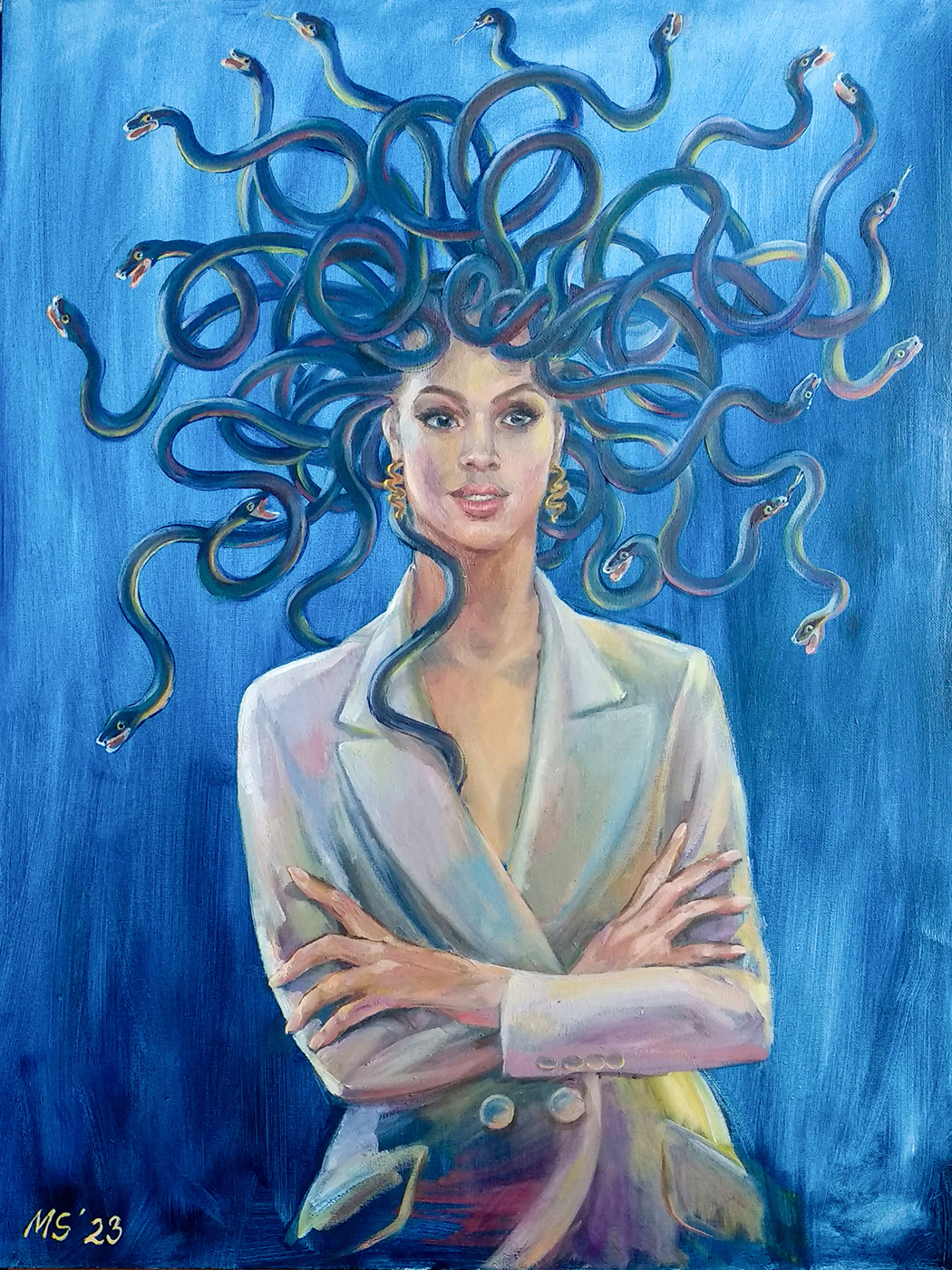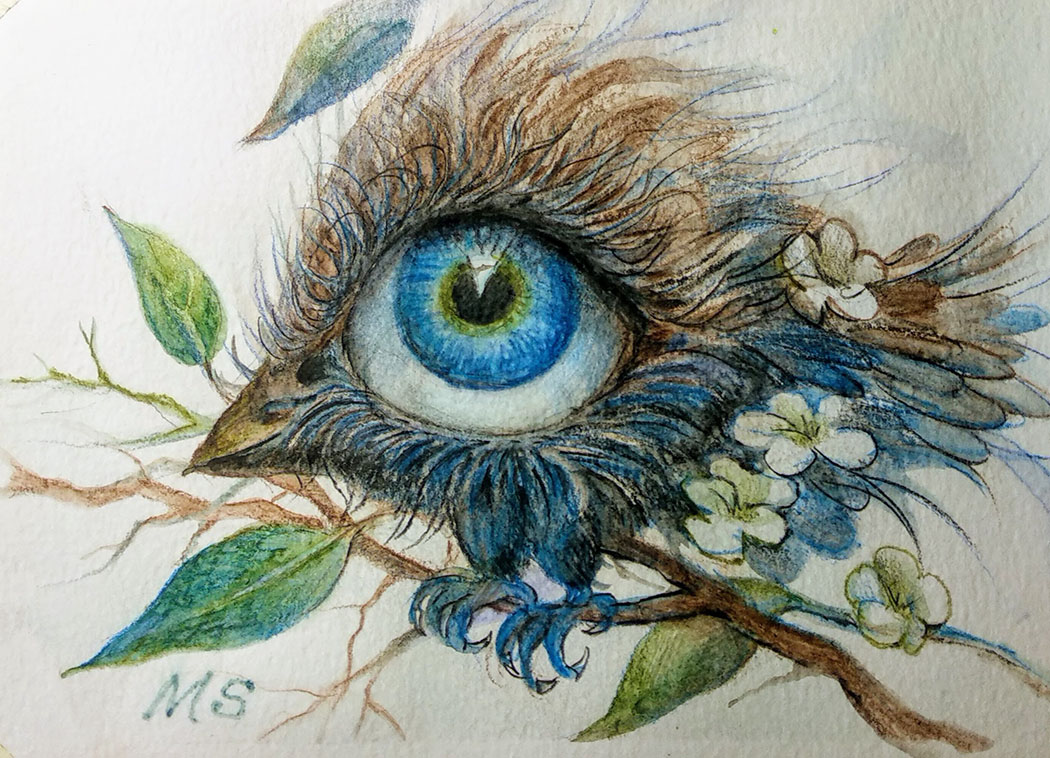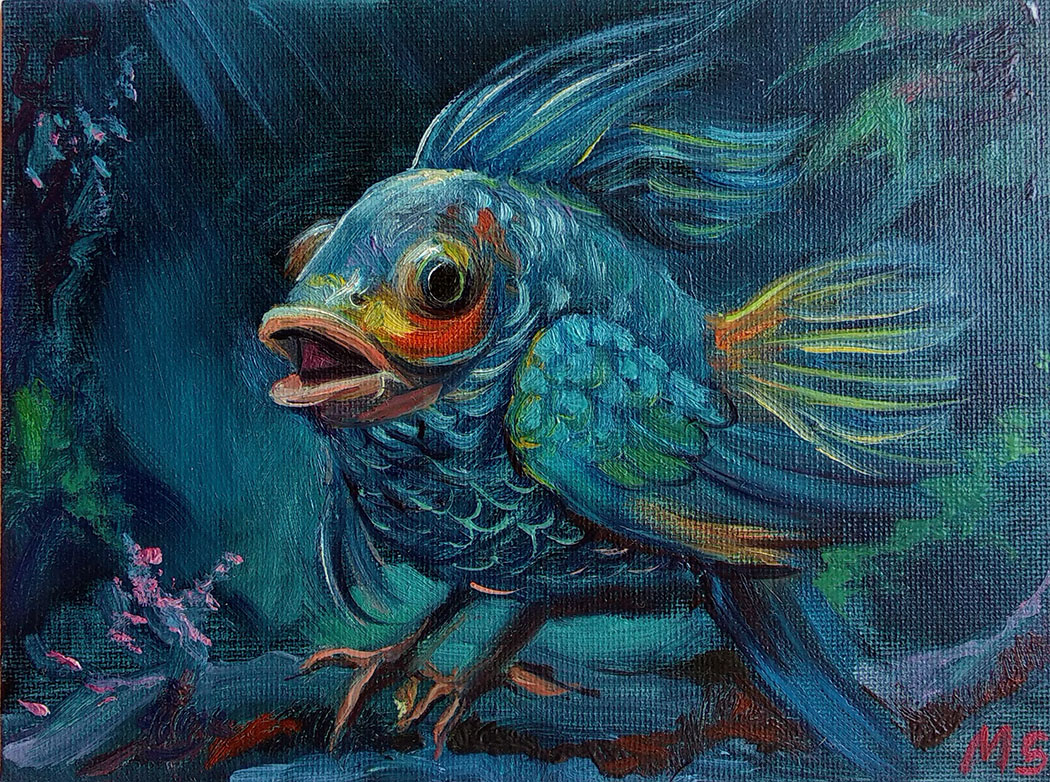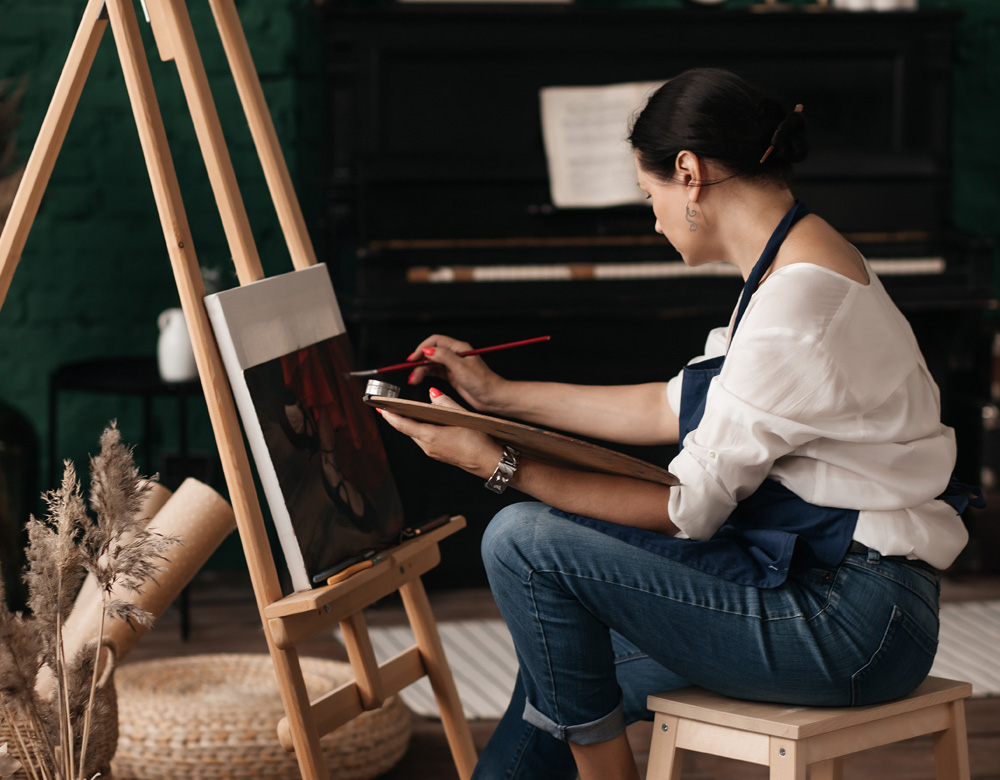Margarita Smirnova (Margo Miro)
Year of birth: 1967.
Your education: Ural State Architectural and Art Academy (Master’s degree in Design).
Describe your art in three words: Meta-ironic surrealism—a combination of metaphysical ideas with ironic surrealism, creating deep and multi-layered images.
Your discipline:
I specialize in figurative painting, using traditional materials—canvas, paper, oil, and acrylic. In my works, I strive to create images where mysticism, surrealism, and irony intertwine. Through these techniques, I explore the inner world of a person, their emotions, and experiences while leaving room for personal interpretation.
And if my paintings make you think, smile, or even get a little lost in your thoughts—then the day wasn’t lived in vain. After all, art should not only decorate walls but also tickle the mind!
Website | Instagram
Your series “Fantastic Beasts” combines female portraits with fantastical hybrid animals. What initially inspired you to explore this unique blend of elements?
The “Fantastic Beasts” series emerged from my interest in the duality of human nature and the interaction between humans and the surrounding world. I’ve always been captivated by the idea that every woman holds an entire universe within herself, full of unexpected facets and mystical sides. We are not just people; we are fantastical beings with rich inner worlds that sometimes manifest in surprising forms.
I enjoy exploring metamorphosis and transformation, both internal and external. The animal symbols intertwined with female images reflect our natural essence, our connection to instincts, strength, and freedom. It’s a way to say: “We are more than what meets the eye.” Within each of us lies both the wild and the gentle, as well as something that goes beyond ordinary understanding. Perhaps my sense of humor and passion for fantasy just couldn’t resist creating such unexpected and delightful hybrids.
 Margarita Smirnova | Medusa Gorgon | 2023
Margarita Smirnova | Medusa Gorgon | 2023
Can you elaborate on the symbolism present in your paintings, particularly in how the hybrid creatures reflect human vulnerabilities and fears?
In my works, the hybrid creatures are not just fantastical images but metaphors reflecting deep aspects of human nature. They symbolize not only our strength and instincts but also the vulnerabilities and fears we often hide from the world.
Each creature, whether it has predatory traits or mysterious mythological features, embodies specific characteristics, emotions, or internal conflicts. For example, the animal features might represent the instinctive side of one’s personality—those aspects we strive to control or suppress, but which nonetheless exert a strong influence on us.
Vulnerability and fears are inherent parts of human nature. They can manifest as anxiety in dreams, unconscious fears, or internal demons that each of us carries. These hybrid beings offer a way to visualize these feelings, bringing them to light, giving them form and face, so that we can understand and accept them as part of ourselves. Ultimately, by exploring our fears through art, we become closer to understanding our essence and finding inner harmony.
So, my “Fantastic Beasts” are not just fantasy; they are a dialogue with our own nature, an invitation to look deep within ourselves and see not just darkness but also light, and to make peace with our “inner monsters.”
You mentioned that the idea for these paintings began with a dream of a woman with horns. How do dreams and subconscious imagery influence your creative process?
For me, dreams are a kind of parallel reality where those aspects of consciousness that remain in the shadows in everyday life are revealed. The dream about the woman with horns became a real catalyst for creating the “Fantastic Beasts” series. There was a strength and enigma in that dream that I couldn’t ignore—such images often spark the beginning of my creative explorations.
I often sketch my dreams; it’s like a “guidebook” to my inner world. I store these sketches in a separate folder, an archive of sorts for my subconscious searches and discoveries. Interestingly, sometimes these sketches, forgotten for many years, unexpectedly “wake up” and find their way into new works. It’s as if my dreams have their own life, waiting for the right moment to become part of my art.
The subconscious is an incredible source of ideas and images, often far more vivid and emotional than anything found in real life. Working with such imagery is like engaging in a dialogue with myself, trying to decipher the messages from within. In the end, dreams become a bridge between what I feel and what I can express through painting.
 Margarita Smirnova | Halo-Eyed Bird | 2023
Margarita Smirnova | Halo-Eyed Bird | 2023
As someone with a background in fashion design, how does this experience influence your approach to painting, especially in terms of composition and the depiction of your subjects?
My experience in fashion design has greatly influenced my approach to painting, especially when it comes to composition and depicting characters. In the world of fashion, every element of a costume carries a specific meaning, and I transfer this principle into my work as an artist.
When I create an image, I always think about the costumes of the characters because they are an integral part of their story and the message I want to convey. Clothing in my paintings is not just a decorative element but an extension of the character, mood, and inner world of the figure.
Fashion and painting intertwine for me, creating a unique visual language where every detail matters and finds its place in the overall picture.
Do you find that your background in various artistic disciplines (such as fashion design, interior design, and caricature) influences the way you approach your current artistic projects?
Absolutely, my experience in various artistic disciplines significantly influences my approach. Each of these fields has contributed to how I see the world and express my ideas through painting.
For instance, working with caricature taught me to capture the essence of an image and convey it with irony and humor. This experience helps me create characters that, despite their fantastical nature, remain recognizable and evoke an emotional response in viewers. My paintings often feature a subtle play with character traits and features, making the images lively and multi-layered.
In design, whether it’s fashion or interior design, I always strive to understand the essence of the problem a person faces and find the optimal solution. This analytical approach seeps into my art as well. When creating a piece, I view it not only as a painting but as a tool for resolving inner conflicts, questions, or experiences. It’s important for me to understand what lies behind external manifestations—be it emotions or behavior. As a designer, I’m used to searching for underlying causes and designing solutions that are not only visually appealing but also functional, “usable” for the viewer.
In painting, I apply this approach by analyzing the psychology and physiology of my characters. I try to understand what drives them, what inner problems they are trying to solve, and how that can be expressed through art. Here, ergonomics takes on a metaphorical meaning: it’s about how the painting “works” for the viewer, how it interacts with their inner world, and what emotions and thoughts it evokes.
My works are not just about creating an image; they are a search for deeper meaning, an attempt to penetrate the essence and offer the viewer a visual solution that can be the beginning of a personal dialogue or even transformation.
 Margo Miro | Fishwing | 2024
Margo Miro | Fishwing | 2024
Your paintings are deeply symbolic and evoke a sense of mystery. Do you have a specific message or feeling you aim to convey to your viewers through this series?
My paintings are indeed full of symbolism and mystery, and this is a conscious choice. I’m not trying to convey a single specific message; rather, I’m interested in creating a space for interpretation where everyone can find something of their own.
It’s important to me that art remains open to different readings. In each work, I embed certain themes—inner strength, vulnerability, transformation—but I leave enough space for the viewer to experience it in their own way and find their own meanings.
The sense of mystery is an invitation to dialogue, to reflection. I want my paintings to evoke not just visual admiration but also an internal resonance, stirring emotions and thoughts that the viewer might not even have been aware of. It’s like a journey into the unknown, where each step reveals something new and unexpected.
So the main message I strive to convey is an invitation to inner exploration. My goal is for the viewer, while looking at my works, to ask themselves questions, find answers, or simply enjoy the process of searching. In the end, art should awaken feelings and open new horizons, and if my paintings do that, then I have achieved my goal.
Your work has been exhibited both in Russia and abroad. How do audiences from different cultures respond to the themes of your “Fantastic Beasts” series?
The “Fantastic Beasts” series has yet to reach physical international exhibitions, but it has already found its way to an international online gallery, where it’s beginning to attract viewers’ attention. I’m still working on this series, preparing for the moment when it can step into the light and captivate audiences from other countries.
Audiences from different cultures have always responded to my works with interest. Art is a universal language, and although each culture brings its unique perspective, the core themes in my work resonate with people’s hearts worldwide. Perhaps someday the “Fantastic Beasts” will embark on their triumphant tour in exhibitions, but for now, they remain in the creative development stage—gathering their mythical power and waiting for their moment to shine.
So, you could say that my “menagerie” is still on its way to international stages, but I’m confident that when it finally emerges, viewers will eagerly dive into its magical atmosphere.
In my work, I strive not only to explore the inner world of a person but also to touch on global issues that concern us all. I am deeply moved by themes of war and peace, globalization, and digitization—the significant shifts that shape our future and determine what the world will be like for future generations.
These ideas are reflected in one of my projects, where through homage to famous artists, I draw historical parallels to ask questions and stimulate reflection. I believe that art has the power not only to create beauty but also to serve as a tool for discussing serious topics. In this project, I explore how past art can intersect with contemporary issues and how lessons from the past can help us comprehend current challenges.
For me, it’s essential that my works not only please the eye but also encourage dialogue, make people think about what’s happening around us, and how we can influence it.


Leave a Reply
You must be logged in to post a comment.